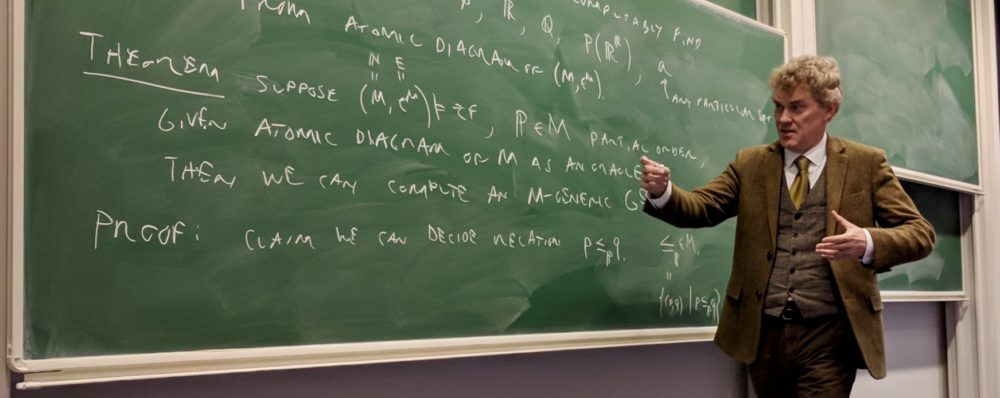 Recently Makoto Kikuchi (Kobe University) asked me the following interesting question, which arises very naturally if one should adopt a mereological perspective in the foundations of mathematics, placing a focus on the parthood relation rather than the element-of relation. In set theory, this perspective would lead one to view the subset or inclusion relation as the primary fundamental relation, rather than the membership relation.
Recently Makoto Kikuchi (Kobe University) asked me the following interesting question, which arises very naturally if one should adopt a mereological perspective in the foundations of mathematics, placing a focus on the parthood relation rather than the element-of relation. In set theory, this perspective would lead one to view the subset or inclusion relation as the primary fundamental relation, rather than the membership relation.
Question. Can there be two different models of set theory, with the same inclusion relation?
We spent an evening discussing it, over delicious (Rokko-michi-style) okonomiyaki and bi-ru, just like old times, except that we are in Tokyo at the CTFM 2015, and I’d like to explain the answer, which is yes, this always happens in every model of set theory.
Theorem. In any universe of set theory , there is a definable relation , different from , such that is a model of set theory, in fact isomorphic to the original universe , for which the corresponding inclusion relation is identical to the usual inclusion relation .
Proof. Let be any definable non-identity permutation of the universe, and let be the function determined by pointwise image under . Since is bijective, it follows that is also a bijection of to , since every set is the -image of a unique set. Furthermore, is an automorphism of , since I had used this idea a few years ago in my answer to the MathOverflow question, Is the inclusion version of Kunen inconsistency theorem true?, which shows that there are nontrivial automorphisms of the universe. Note that since , it follows that any instance of nontriviality in leads immediately to an instance of nontriviality in .
Using the map , define . By definition, therefore, is an isomorphism of . Let us show that . Since is nontrivial, there is an -minimal set with . By minimality, and so . But as mentioned, . So we have , but and hence . So the two relations are different.
Meanwhile, consider the corresponding subset relation. Specifically, is defined to mean , which holds if and only if ; but since is surjective, this holds if and only if , which as we observed at the beginning of the proof, holds if and only if . So the corresponding subset relations and are identical, as desired.
Another way to express what is going on is that is an isomorphism of the structure with , and so is in fact that same as the corresponding inclusion relation that one would define from . QED
Corollary. One cannot define from in a model of set theory.
Proof. The map is a -automorphism, and so it preserves every relation definable from , but it does not preserve . QED
Nevertheless, I claim that the isomorphism type of is implicit in the inclusion relation , in the sense that any other class relation having that same inclusion relation is isomorphic to the relation.
Theorem. Assume ZFC in the universe . Suppose that is a class relation for which is a model of set theory (a weak set theory suffices), such that the corresponding inclusion relation is the same as the usual inclusion relation . Then the two membership relations are isomorphic
Proof. Since the singleton set has exactly two subsets with respect to the usual relation — the empty set and itself — this must also be true with respect to the inclusion relation defined via , since we have assumed . Thus, the object is also a singleton with respect to , and so there is a unique object such that . By extensionality and since every object has its singleton, it follows that is both one-to-one and onto. Let be the inverse permutation.
Observe that . Thus,
Using -recursion, define . The map is one-to-one by -recursion, since if there is no violation of this for the elements of , then we may recover from by applying to the elements of and then using the induction assumption to find the unique from for each , thereby recovering . So is injective.
I claim that this map is also surjective. If for any , then there must be an element of that is not of the form for any . Since is surjective, this means there is with for any . Continuing, there is with and for any . Let . Since , it follows that the -elements of are precisely the ’s. But , and so . So has no -minimal element, violating the axiom of foundation for , a contradiction. So the map is a bijection of with .
Finally, we observe that because it follows that the map is an isomorphism of with , as desired. QED
The conclusion is that although is not definable from , nevertheless, the isomorphism type of is implicit in , in the sense that any other class relation giving rise to the same inclusion relation is isomorphic to .
Meanwhile, I do not yet know what the situation is when one drops the assumption that is a class with respect to the universe.
Question. Can there be two models of set theory and , not necessarily classes with respect to each other, which have the same inclusion relation , but which are not isomorphic?
(This question is now answered! See my joint paper with Kikuchi at Set-theoretic mereology.)
 Recently Makoto Kikuchi (Kobe University) asked me the following interesting question, which arises very naturally if one should adopt a mereological perspective in the foundations of mathematics, placing a focus on the parthood relation rather than the element-of relation. In set theory, this perspective would lead one to view the subset or inclusion relation
Recently Makoto Kikuchi (Kobe University) asked me the following interesting question, which arises very naturally if one should adopt a mereological perspective in the foundations of mathematics, placing a focus on the parthood relation rather than the element-of relation. In set theory, this perspective would lead one to view the subset or inclusion relation 
